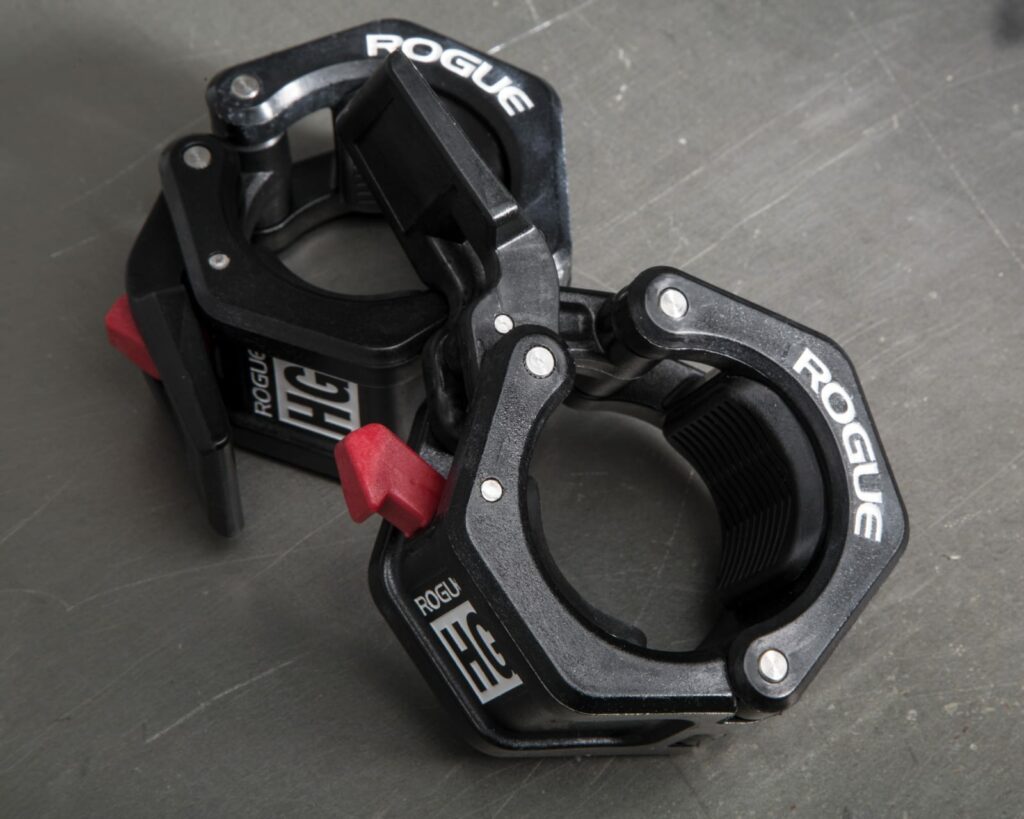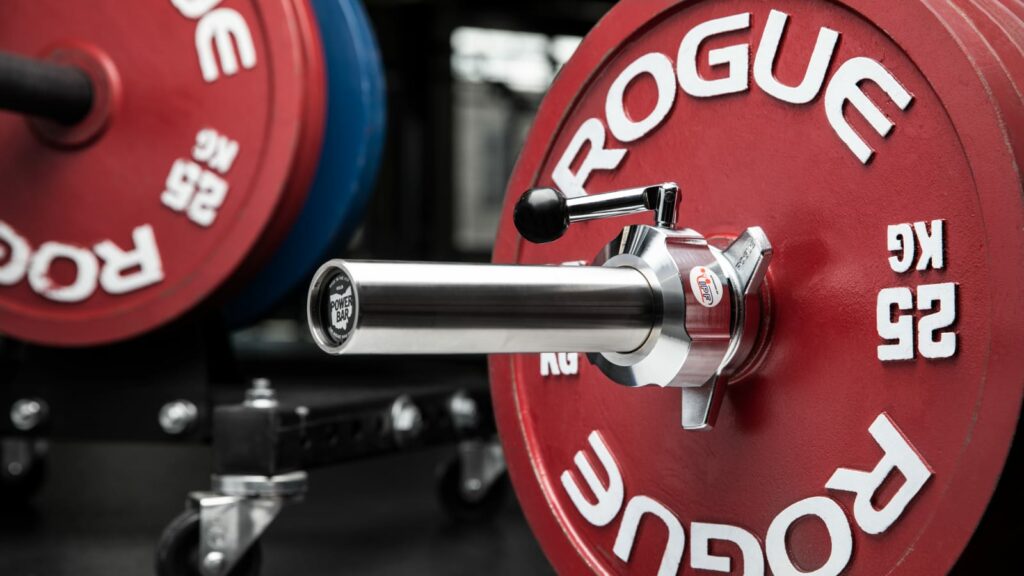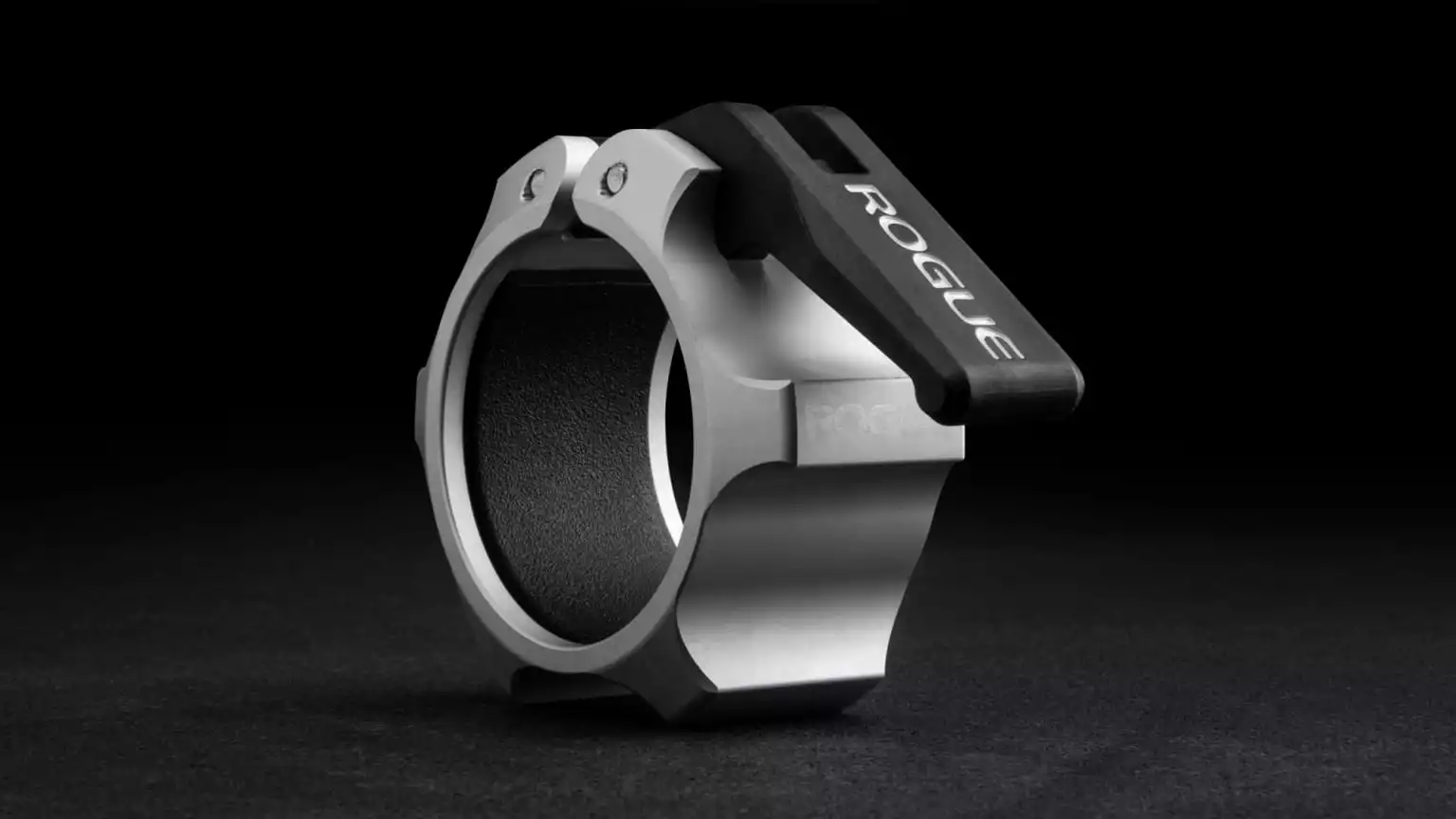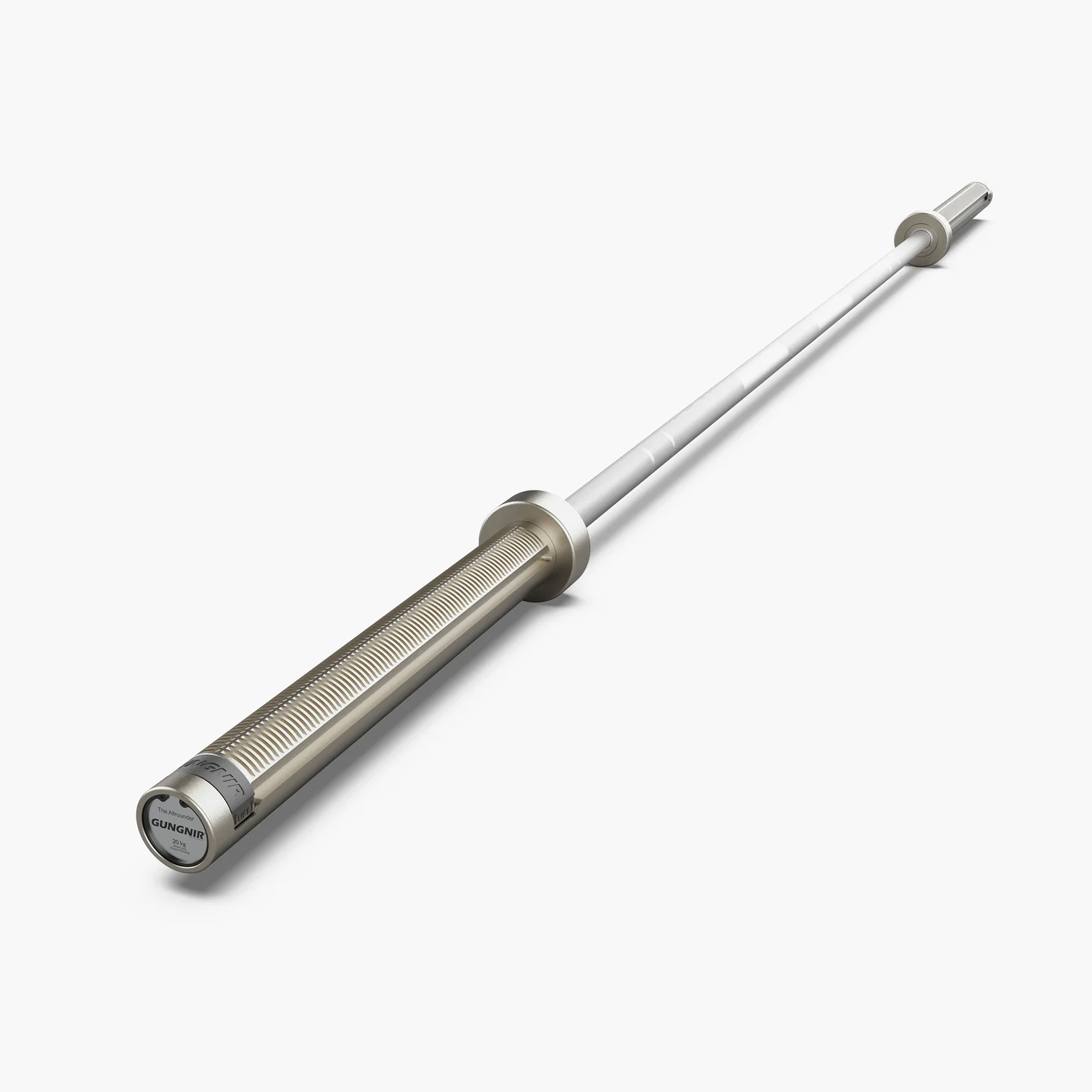Selecting the right barbell collars is crucial for both safety and performance in weightlifting. In this guide, I’ll share my expertise and hands-on testing experience to help you choose the best barbell collars, ensuring safe and effective workouts.
Let’s get started!
Table Of Contents
- 1 What Are The Best Barbell Collars?
- 1.1 Best Overall – Rogue USA Aluminum Collars
- 1.2 Runner-Up – Lock-Jaw Pro 2 Barbell Collars
- 1.3 Best For Specialty Bars – Proloc Collars
- 1.4 Most Premium – Eleiko Öppen Collars
- 1.5 Budget Pick – Clout Fitness Olympic Barbell Clamps
- 1.6 Best-Looking – Rogue OSO CP-1 Polymer Collars
- 1.7 Best For Dumbbell Handles – Strengthco Barbell Collars
- 1.8 Best Competition Collars – Rogue KG Competition Collars
- 1.9 Best Lightweight Barbell Collars – OSO Mighty Collars
- 1.10 Best Barbell Collars On Amazon – GORILLA JAW Olympic Barbell Clamps
- 1.11 Barbell With Built-In Collars – Gungnir Allrounder Bar
- 1.12 Best For Axle Bars – Rogue HG 2.0 Axle Collars
- 2 Why You Should Trust Me
- 3 What Are Barbell Collars & Why They’re Important
- 4 How To Use Barbell Collars
- 5 How I Chose These Barbell Collars
- 6 Types Of Barbell Collars
- 7 Best Barbell Collar Competitors
- 8 Frequently Asked Questions
- 9 Conclusion
What Are The Best Barbell Collars?
- Best Overall – Rogue USA Aluminum Collars
- Runner-Up – Lock-Jaw Pro 2 Barbell Collars
- Best For Specialty Bars – Proloc Collars
- Most Premium – Eleiko Öppen Collars
- Budget Pick – Clout Fitness Olympic Barbell Clamps
- Best-Looking – OSO CP-1 Polymer Collars
- Best For Dumbbell Handles – Strengthco Barbell Collars
- Best Competition – Rogue KG Competition Collars
- Best Lightweight – OSO Mighty Collars
- Best On Amazon – GORILLA JAW Olympic Barbell Clamps
- Barbell With Built-In Collars – Gungnir Allrounder Bar
- Best For Axle Bars – Rogue HG 2.0 Axle Collars
Best Overall – Rogue USA Aluminum Collars
Discover the Rogue USA Aluminum Collars, crafted from high-grade 6061 Billet Aluminum for unmatched strength and lightweight performance. These collars feature a nylon lever and rubber lining for barbell protection and ease of use. With a wider, sturdy lever and multiple Cerakote color options, these US-made, rust-resistant collars are a trusted choice for fitness enthusiasts worldwide.
SPECS
PROS
CONS
Runner-Up – Lock-Jaw Pro 2 Barbell Collars
SPECS
PROS
CONS
Best For Specialty Bars – Proloc Collars
Transform your workout routine with the versatile Proloc Collars. Boasting a distinct design, these collars are crafted from a rugged nylon resin that ensures longevity. They are a perfect fit for specialty bars and are incredibly straightforward to operate. Available in a stunning range of colors from classic black to vivacious pink, these collars add a pop of color to your workout gear.
SPECS
PROS
CONS
Most Premium – Eleiko Öppen Collars
Introducing the Eleiko Öppen Collars, a high-end embodiment of functionality and style. These robust clamps, constructed from superior-quality aluminum and nitrile rubber, ensure a firm hold, guaranteeing a safe and efficient workout. Their captivating silver color, combined with an innovative open-end design, not only adds a touch of elegance to your gear but also ensures seamless operation.
SPECS
PROS
CONS
Budget Pick – Clout Fitness Olympic Barbell Clamps
Specs
PROS
CONS
Best-Looking – Rogue OSO CP-1 Polymer Collars
The Rogue OSO CP-1 Polymer Barbell Collars blend cutting-edge design with exceptional functionality, featuring rubberized interior plugs for an unbeatable grip on the bar and a sleek, updated handle for ease of use. These heavy-duty nylon collars, made in the USA, ensure rock-solid stability and a smooth operation on 50MM Olympic Bar Sleeves, making them the best-looking and most reliable option for your lifting needs.
SPECS
PROS
CONS
Best For Dumbbell Handles – Strengthco Barbell Collars
SPECS
PROS
CONS
Best Competition Collars – Rogue KG Competition Collars
Unveiling the magnificent Rogue KG Competition Collars. A paragon of aesthetic beauty and performance prowess, they're meticulously crafted from billet steel, flaunting a hard chrome finish that's both visually stunning and rust-resistant. These impressive collars cater to the 2" Olympic sleeves and come at a width range of 3" - 3.625". Notably, they're built for precision with a weight of 5.0kg per pair, accurate up to a tight tolerance of +/- 10 grams. Priced at $190 for a pair, they promise the quality and strength synonymous with the style - lock.
SPECS
PROS
CONS
Best Lightweight Barbell Collars – OSO Mighty Collars
Introducing the OSO Mighty Collars - the perfect combination of durability, ease, and style. These premium collars are fabricated with aircraft-grade 6061 aluminum, featuring an attractive, thin, and lightweight design that weighs just 0.3lb per pair. Complemented with a rubber-lined interior for bar protection, these collars promise an ideal blend of convenience and functionality. Designed to fit 2" Olympic sleeves, they come in gunmetal and blue, providing a stylish accent to your workout gear. Sold affordably at $35 per pair, these American-made collars exude quality without breaking the bank.
SPECS
PROS
CONS
Best Barbell Collars On Amazon – GORILLA JAW Olympic Barbell Clamps
SPECS
PROS
CONS
Barbell With Built-In Collars – Gungnir Allrounder Bar
SPECS
PROS
CONS
Best For Axle Bars – Rogue HG 2.0 Axle Collars
Introducing the Rogue HG 2.0 Axle Collars - a must-have tool for your training regime. Created with tenacity and ease of use in mind, these collars are designed to clamp on 1.9” axle barbells effortlessly. With a hardy construction made from resilient resin materials, they offer a durable solution for maintaining barbell integrity during rigorous workouts. With a featherlight weight of only 0.5 lbs per pair, you won't even notice they're there. Moreover, the one-hand removal, super-fast tightening, and releasing mechanism make them a dream to operate. These collars ensure excellent grip without causing any damage to your barbells.
SPECS
PROS
CONS
Why You Should Trust Me
My guidance on barbell collars comes from a place of genuine experience and extensive research, not just theoretical knowledge. While I haven’t personally used every collar out there, the ones I recommend are chosen through a meticulous process that goes beyond surface-level reviews. I dive deep into each product’s specifications, user experiences, and manufacturer information.
Potential earnings never sway my recommendations; I only suggest products I would confidently use myself. This commitment to thorough research and unbiased advice is what I bring to the table, ensuring you get reliable and honest recommendations for your lifting needs.
What Are Barbell Collars & Why They’re Important
Barbell collars are small but vital devices that secure weight plates onto a barbell. Their primary role is to ensure safety during lifting. By firmly locking the weights in place, they prevent the plates from sliding off, which could lead to accidents and injuries. This stability is crucial, especially during dynamic lifts where the risk of weights shifting is higher.
Additionally, the right set of collars can significantly improve your lifting experience. They provide peace of mind, allowing you to focus solely on your form and performance without the distraction of wobbling or unbalanced weights. In essence, barbell collars are not just accessories; they’re essential tools for safe and comfortable weightlifting.
How To Use Barbell Collars
Using barbell collars is straightforward, but it’s crucial to do it right for maximum safety. Here’s a quick rundown on how to apply them:
- Slide the Collar onto the Barbell – After loading your weights, slide the collar onto the end of the barbell.
- Secure the Collar
- Spring-Style – Squeeze the handles and slide it against the weights, then release to clamp.
- Clamp and Lock-Style – Open the latch, place it snugly against the weights, and close the latch to lock.
- Spinlock – Twist the collar until it’s tight against the weights.
- Double-Check for Stability – Give the collar a gentle tug to ensure it’s securely fastened and the weights don’t move.
- Repeat on the Other Side – Always balance your barbell with collars on both ends.
Remember, the key is to ensure the collar is tight and secure, so your weights stay firmly in place during your lifts.
How I Chose These Barbell Collars
In choosing these barbell collars, there were a couple of factors I made sure to pay attention to. Like always, I ensure that every accessory or piece of equipment I recommend is something I would personally invest in and use. Here are the main things I considered when choosing this specific list.
Overall Construction and Materials
In selecting barbell collars, I combined a focus on both their overall construction and the materials used. It was essential to find collars that were not only solid in design but also made from materials that enhanced durability and performance. I leaned towards collars made from steel or aluminum for their strength, especially for heavy lifting, while also considering plastic for its lightness in everyday training. The construction quality was scrutinized to ensure they could withstand regular use without compromising functionality.
Collar Style
The style of the collar played a significant role in my choice. Clamp collars stood out for their ease of use, ideal for quick weight changes. Lock-style collars, offering a more secure hold, were my preference for heavy lifting, despite being a bit slower to adjust. Spring collars, being simple and reliable, were also considered for their affordability and traditional appeal.
Width and Holding Capacity
I assessed the width of the collars in relation to how well they fit various barbells and their holding capacity. Wider collars provided a more secure grip, essential for dynamic movements and heavy lifts. I researched how these collars performed under different conditions to ensure they maintained a firm hold, keeping weights securely in place without any slippage.
Convenience
Convenience was a key factor. My selections were influenced by finding a balance between quick, hassle-free adjustments and the security of the weights, ensuring the collars were practical for various workout scenarios.
Value and Warranty
The value of each collar, considering its price, features, and longevity, was carefully evaluated. I looked for collars that offered the best return on investment, balancing quality with affordability. Additionally, the warranty offered by each product was a significant factor, as it added an extra layer of trust and assurance in the product’s quality and durability.
Accurate Weight
In my selection, the actual weight of the collars was a critical factor, especially for competitive lifting. I chose collars with precisely specified weights to ensure accuracy in the total weight lifted. This precision is crucial for fair competition and for lifters who track their progress meticulously. By selecting collars with clearly defined weights, I aimed to provide lifters with the confidence that they are lifting the exact weight they set out to lift.
Fit
The fit of the collar on the barbell was a top priority. I checked to see how they held onto both Olympic and specialty bars to ensure a snug, secure fit. It was important to find collars that, while being versatile enough to fit different bar types, didn’t compromise on stability. This led me to choose collars that, despite their universal claims, truly delivered on providing a reliable and secure fit, essential for both safety and performance.
Aesthetics
While functionality and performance were my primary concerns, I also considered the aesthetic appeal of the collars. I looked for designs that were both functional and visually appealing, adding a touch of style to the equipment. The chosen collars stood out with their sleek designs and varied color options, catering to those who value the visual aspect of their workout gear, without sacrificing quality and performance.
Types Of Barbell Collars
When it comes to outfitting your barbell, the type of collar you choose can significantly impact your lifting experience. Each style has its unique features, benefits, and situations where it shines. Here’s a breakdown of the different types of barbell collars I considered, highlighting their specific uses and characteristics to help you make an informed choice for your lifting needs.
Spring

These are your classic collars, simple and straightforward. They’re great for standard gym workouts but might not be the best for dynamic exercises due to their limited grip strength. Their simplicity is a plus, but they do require a bit more effort to attach and remove.
Clamp

I appreciate these for their user-friendliness. They’re a breeze to use, making them perfect for workouts where you’re frequently changing weights. The quick-release mechanism is a real time-saver, though they may not offer the same level of security as heavier-duty options.
Lever

Lever Collars are a type of quick-release collar that uses a lever to secure the collar onto the barbell. They are easy to use and provide a secure hold.
To attach a lever collar, you slide it onto the barbell sleeve and then flip the lever to lock it in place. To remove it, you simply flip the lever in the opposite direction.
Each type of collar has its advantages and is suited to different types of workouts and personal preferences.
Lock-Style

These are the heavy hitters. Ideal for serious lifting, they provide a solid and secure grip, ensuring weights stay firmly in place. They’re a bit more involved to set up and adjust, but for heavy lifting, they’re my go-to for their reliability.
Competition

Competition Collars are used in professional weightlifting competitions. They are usually made of high-quality metal and are heavier than other types of collars. This added weight ensures a secure hold on the weights, which is crucial during a competition. They often feature a locking mechanism for added security.
Strap
The versatility of strap collars is impressive. They adjust easily and can fit a variety of barbells, making them a flexible option for different training setups. While they’re convenient, they might not offer the same level of security as metal collars, especially under heavy loads.
Spinlock

These have a more traditional role, often seen with older barbell sets. You still commonly see them on spinlock dumbbells like the ones pictured above.
They screw on for a secure fit, which is great for stability, but they’re not as quick to adjust as clamp or lock-style collars. They’re reliable but might not suit fast-paced workouts where you need to change weights quickly.
Best Barbell Collar Competitors
In evaluating the vast array of barbell collars available, I had to be discerning in my choices, focusing on what best suits a wide range of lifting needs. Here’s why some popular models didn’t make my final cut:
- Lock-Jaw Hex & OLY 2 Olympic Barbell Collars – While they’re both still solid options, the PRO 2 are a much better option.
- Titan Quick Release Weight Clamp Collars – These are quick to adjust but they’re also quick to release as the name implies. They don’t have a solid hold and this is common in all the reviews I read.
- ETHOS Lock-Jaw – These are too expensive for how basic and loose they get. The Lock-Jaw Pro 2 is far superior for around the same price.
- REP Fitness & CAP Barbell Spring Collars – These are just generic spring collars and there are much better versions for around the same price.
- OSO CM-1 Metal Collars – These are great but the OSO CP-1 collars are cheaper and better rated by actual lifters. Sure, the CM-1 collars might be popular because they look better, but the CP-1 option looks good enough honestly.
- Rogue OSO Barbell Collar – Considering the price for these and the fact they’re made by Rogue, simply put, these suck.
- Fringe Sport SuperStraps Collars – These might have a cool design but that doesn’t change the fact that they slide and require constant adjustment.
- PRx Performance Talon Barbell Collars – These have an interesting design but unlike regular collars, they require maintenance to maintain their stickiness. Not a fan of doing extra cleaning on collars when NO OTHER collar requires it.
- SnapClips Barbell Collars – These have a similar design to the PRx Talon Collars which I’m not a huge fan of. They don’t hold anywhere near as well and if I don’t recommend those, I don’t recommend these either.
- Eleiko IWF Competition Collars – Unless you’re a truly competitive lifter, these are way too expensive.
- Iron Lab & WARM BODY COLD MIND – These are both pretty popular on Amazon, and for most people, I think they’re fine. However, there are cheaper collars that are much better overall. These are both the exact same collar with different logos.
- Muscle Clamps – These are okay for Powerlifting but for Olympic lifting and CrossFit, they’re going to bounce off. Plus, they’re expensive compared to much better options.
- Get RX’d Proloc 1 Magnet Collars – These are basically the same as the Rogue Proloc collars but they have a built-in magnet to lock it onto your rack. They’re about ten bucks more for this so just get the one you prefer.
In my selection, I aimed for a balance between functionality, ease of use, durability, and cost-effectiveness, ensuring the collars I chose would meet the diverse needs of lifters at all levels.
Frequently Asked Questions
Conclusion
Selecting the right barbell collars is a blend of safety, functionality, and personal preference. While I’ve shared my insights and choices, I’m eager to hear from you. What do you think of the collars I’ve selected? Do you have favorites or experiences with any of these models? Drop your thoughts and experiences in the comments below. Your input not only enriches this discussion but also helps fellow lifters make informed decisions.
Until next time,
-Dante












